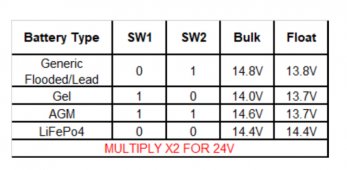Hi, I'm using an 2000 watt AIMS inverter/charger that was made before LiFEP04 batteries became popular, circa 2013. It doesn't have a setting for LiFEP04 batteries.
Here are the available profiles, from a photo of the unit:

In response to a similar inquiry, @snoobler suggested using the AGM1 profile. (14.1 fast, 13.4 float). Apparently on newer units AIMS suggests the SLA profile for lithium batteries (14.4 fast, 13.6 float).
The AIMS will charge at up to 30 amps.
I'm running two 24v 50ah LiFePo4 batteries in parallel. Here's the specs on them re charging:
Can you please tell me which profile you recommend, and how to use it? Following @snoobler's lead, I'm guessing set it to AGM1, keep an eye on the battery voltage, and then turn it off when the charge maxes out. I understand that LiFEP04 don't require a float. Thanks for your guidance.
Here are the available profiles, from a photo of the unit:

In response to a similar inquiry, @snoobler suggested using the AGM1 profile. (14.1 fast, 13.4 float). Apparently on newer units AIMS suggests the SLA profile for lithium batteries (14.4 fast, 13.6 float).
The AIMS will charge at up to 30 amps.
I'm running two 24v 50ah LiFePo4 batteries in parallel. Here's the specs on them re charging:
| Power and Energy | |
| Nominal Charge | 25.6v |
| Charge Voltage | 30.0v |
| Continuous Charge Rate | 20 Amps |
| Continuous Discharge Rate | 50 Amps |
| Peak Discharge Rate (<2 minutes) | 70 Amps |
| Capacity (Amp Hours) | 50 AH |
| Capacity (watts) | 1280 Watt-Hours |
Can you please tell me which profile you recommend, and how to use it? Following @snoobler's lead, I'm guessing set it to AGM1, keep an eye on the battery voltage, and then turn it off when the charge maxes out. I understand that LiFEP04 don't require a float. Thanks for your guidance.



